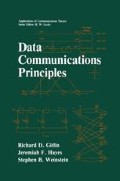Abstract
The theme of this chapter might well be “…timing is everything.” In the course of our discussion in Chapter 4, we saw that the detection of a baseband digital data sequence presumed proper timing at the receiver. (See Section 4.10, particularly.) The same requirement for timing is present in the detection of passband signals; however, as we saw in Section 5.2, carrier phase coherency is also necessary. The roles of each of these synchronization subsystems are shown in Figure 6.1a. The carrier tracking system provides an estimate of the received carrier phase θ^, while the timing recovery system provides an estimate of the proper sampling epoch to the receiver sampling system Ä^. The effect of a poorly designed carrier loop will be to increase the dispersion of the received symbols about their nominal values, bringing the received points considerably closer to the decision boundaries and decreasing the margin against an error (caused say by a noise burst); of course, large phase perturbations can cause errors without any noise. In Figure 6.1b we show how the transmitted symbol s 1 is rotated by phase jitter to the point u, and then further distorted by noise to the point z; note that the received point is within the decision region associated with s 2 so that an error will be made. Similarly, timing phase errors will cause the receiver to sample away from the maximum eye opening, and reduce the margin for error. It is the purpose of this chapter to present the various aspects of synchronization.
Access this chapter
Tax calculation will be finalised at checkout
Purchases are for personal use only
Preview
Unable to display preview. Download preview PDF.
References
H. L. Van Trees, Detection, Estimation, and Modulation Theory, Wiley, 1968.
A. J. Viterbi, Principles of Coherent Communications, McGraw-Hill, 1966.
W. C. Lindsey, Synchronization Systems in Communications, Prentice-Hall, 1972.
E. A. Lee and D. G. Messerschmitt, Digital Communication, Kluwer Academic Publishers, 1988.
L. E. Franks, “Carrier and Bit Synchronization in Data Communications — A Tutorial Review,” IEEE Trans. on Communications, Vol. Com.-28, No. 8, pp. 1107–1121, August 1980.
W. C. Lindsey and M. K. Simon, Telecommunication Systems Engineering, Prentice-Hall, 1973.
D. D. Falconer, “Jointly Adaptive Equalization and Carrier Recovery in Two-Dimensional Digital Communication Systems,” Bell System Tech. Journal, Vol. 55, No. 3, March 1976.
R. D. Gitlin and J. Salz, “Timing Recovery in PAM Systems,” Bell System Tech. Journal, Vol. 50, pp. 1645–1669, May/June 1971.
J. E. Mazo, “Jitter Comparison of Tones Generated by Squaring and Fourth-Power Circuits,” Bell System Tech. Journal, Vol. 57, pp. 1489–1498, May/June 1978.
K. H. Mueller and M. Müller, “Timing Recovery in Digital Synchronous Data Receivers,” IEEE Trans. on Communications, Vol. 24, No. 5, pp. 516–531, May 1976.
R. W. Lucky, J. Salz, and E. J. Weldon, Jr., Principles of Data Communication, McGraw-Hill, 1968.
R. D. Gitlin and J. F. Hayes, “Timing Recovery and Scramblers in Data Transmission,” Bell System Tech. Journal, Vol. 54, No. 2, March 1975.
W. W. Peterson and E. J. Weldon, Error Correcting Codes, Second Edition MIT Press, Cambridge, Mass., 1972.
R. D. Gitlin and H. C. Meadors, Jr., “Center Tap Tracking Algorithms for Timing Recovers,” AT&T Tech. Journal, Vol. 66, Issue 6, pp. 63–78, Nov/Dec. 1987.
G. Ungerboeck, “Fractional Tap-Spacing Equalizer and Consequences for Clock Recovery in Data Modems,” IEEE Transactions on Communications, COM-24, No. 8, pp. 856–864, August 1976.
H. Meyr and G. Ascheid, Synchronization in Digital Communications, John Wiley, 1990.
Author information
Authors and Affiliations
Rights and permissions
Copyright information
© 1992 Springer Science+Business Media New York
About this chapter
Cite this chapter
Gitlin, R.D., Hayes, J.F., Weinstein, S.B. (1992). Synchronization: Carrier and Timing Recovery. In: Data Communications Principles. Applications of Communications Theory. Springer, Boston, MA. https://doi.org/10.1007/978-1-4615-3292-7_6
Download citation
DOI: https://doi.org/10.1007/978-1-4615-3292-7_6
Publisher Name: Springer, Boston, MA
Print ISBN: 978-1-4613-6448-1
Online ISBN: 978-1-4615-3292-7
eBook Packages: Springer Book Archive

